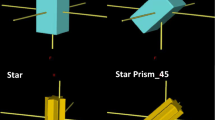Abstract
Purpose
Distance measures are required for diagnoses, therapy decision and documentation. With today’s high-resolution CT and MR imaging techniques, high- quality images have become possible. Yet, manual measurement can be tedious. We present a method for automatically determining different distance-based measures on segmented anatomic structures, like shortest distances, diameters, and wall thicknesses.
Methods
Our method is inspired from computational geometry and based on a surface mesh representation. The computation takes all primitives (points, edges, faces) into account and organizes them efficiently in a spatial tree structure. We followed the generic design paradigm in order to achieve maximum flexibility.
Results
The generic approach allows for a variety of intervention-relevant distance measures to be computed, using only a single type of data structure. For shortest distance, our approach in empirical tests turned out to be more efficient than previous methods from medical application literature. Besides the numerical value, also its defining geometric primitives are determined.
Conclusions
The presented technique is both, fast and flexible. It can be used to interactively derive automatic distance measures for arbitrary mesh-based segmentations. Due to the geometrically exact measurements, it is possible to reliably estimate safety margins, assess possible infiltrations and other clinically relevant measures. To exploit this benefit, the method requires precise segmentations as input data.
Similar content being viewed by others
References
Bobrow JE (1989) A direct minimization approach for obtaining the distance between convex polyhedra. Int J Robot Res 8(3): 65–76
Dornheim J, Dornheim L, Preim B, Strauß G (2008) Modellbasierte segmentierung von weichgewebestrukturen in CT-datensätzen de halses. In: Dirk B, Bohn S, Hoffmann J (eds) Curac.08 Tagungsband. pp 197–200, Sept 2008
Dornheim J, Tietjen C, Preim B, Hertel I, Strauß G (2008) Image analysis and visualization for the preoperative planning of neck dissections. In: 5th international conference on computer aided surgery around the head
Fabbri R, Costa LDF, Torelli JC, Bruno OM (2008) 2D Euclidean distance transform algorithms: a comparative survey. ACM Comput Surv 40(1): 1–44
Fabri A, Giezeman G-J, Kettner L, Schirra S, Schönherr S (2000) On the design of CGAL, a computational geometry algorithms library. Softw Pract Exp 30(11): 1167–1202
Faverjon B (1989) Hierarchical object models for efficient anti-collision algorithms. In: Proceedings of the IEEE ICRA, vol 1. pp 333–340
Gilbert EG, Johnson DW (1988) A fast procedure for computing the distance between complex objects in three space. IEEE J Robot Autom 4(2): 193–203
Gottschalk S, Lin MC, Manocha D (1996) OBBTree: a hierarchical structure for rapid interference detection. In: SIGGRAPH ’96. pp 171–180
Hastreiter P, Rezk-Salama C, Tomandl B et al (1998) Fast analysis of intracranial aneurysms based on interactive direct volume rendering and CTA. In: MICCAI ’98: proceedings of the first international conference on medical image computing and computer-assisted intervention. pp 660–669
Jones MW, Baerentzen JA, Sramek M (2006) 3D distance fields: a survey of techniques and applications. IEEE Trans Vis Comput Graph 12(4): 581–599
Kawachi K, Suzuki H (2000) Distance computation between non-convex polyhedra at short range based on discrete voronoi regions. In: Proceedings of geometric modeling and procesing. pp 123–128
Langetepe E, Zachmann G (2006) Geometric data structures for computer graphics
Ledoux H (2007) Computing the 3d voronoi diagram robustly: an easy explanation. In: ISVD ’07: proceedings of the 4th international symposium on voronoi diagrams in science and engineering. pp 117–129
Lin MC, Canny JF (1991) A Fast Algorithm for Incremental Distance Calculation. In: Proceedings of the IEEE ICRA, vol 2. pp 1008–1014
Preim B, Bartz D (2007) Visualization in medicine: theory, algorithms, and applications, chapter 13—measurements in medical visualization. pp 313–339
Quinlan S (1994) Efficient distance computation between non- convex objects. In: Proceedings of the IEEE ICRA, vol 4. pp 3324–3329
Sack J-R, Urrutia J (2000) Handbook of computational geometry
Sud A, Govindaraju N, Gayle R, Kabul I, Manocha D (2006) Fast proximity computation among deformable models using discrete Voronoi diagrams. ACM Trans Graph 25(3): 1144–1153
Author information
Authors and Affiliations
Corresponding author
Rights and permissions
About this article
Cite this article
Rössling, I., Cyrus, C., Dornheim, L. et al. Fast and flexible distance measures for treatment planning. Int J CARS 5, 633–646 (2010). https://doi.org/10.1007/s11548-010-0519-3
Received:
Accepted:
Published:
Issue Date:
DOI: https://doi.org/10.1007/s11548-010-0519-3




